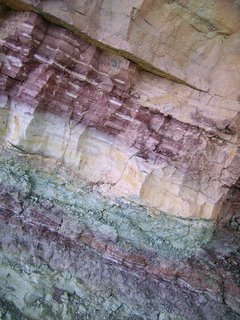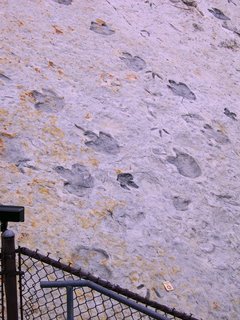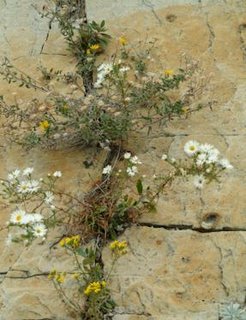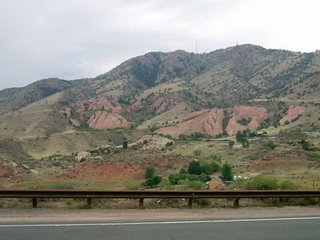
Somewhere in those layers of shale and sandstone were some pretty amazing bog plants at one time. I never really understand these geologic cuts, I guess because I can't conceive of layers of rock that were once flat on the ground being tilted on their side. Yeah, I know, uplift and mountain building and all that, but I think interpretive signs were meant for people like me who can't visualize it otherwise. And how about these fossilized ripples in the sand that were once the beach for an ancient sea that stretched from Colorado to Missouri?

This site is on the hogback ridge west of Denver, which would have been the edge of the seaway. You can walk right up to some dinosaur tracks along here too. I love the tenacity of plants that insist on growing in cracks in the rock face. These are asters and sages. They remind me of the volunteers that spring up in the cracks in my driveway, though that's usually a malva plant that doesn't want to stay in its crowded bed.


 This photo is a shot of the surrounding scenery today, lots of red sandstone which also is what the famous Red Rocks Amphitheatre is carved out of, which is just around the bend. It's a favorite venue for every band that ever played there, but back in the day the Brontosaurus made the area rock.
This photo is a shot of the surrounding scenery today, lots of red sandstone which also is what the famous Red Rocks Amphitheatre is carved out of, which is just around the bend. It's a favorite venue for every band that ever played there, but back in the day the Brontosaurus made the area rock.
3 comments:
What fabulous pictures! Especially the last one of the mountains. I have to learn how to take better mountain pictures.
That's funny you should say that about learning to take better mountain pictures, la gringa. I'm still learning to use my digital camera and when I took that shot I remembered to set it on the "mountain" icon which you're supposed to use for landscapes. Then I took another one with a standard shot and I liked it better! Well, that's the good thing about digital, you can "peek and delete"!
Great shots and very interesting! I like that first photo with all the layers best, looks like art! And Nr. 4, herbs are even growing with very little soil in the smallest spaces. Life is everywhere!
Post a Comment